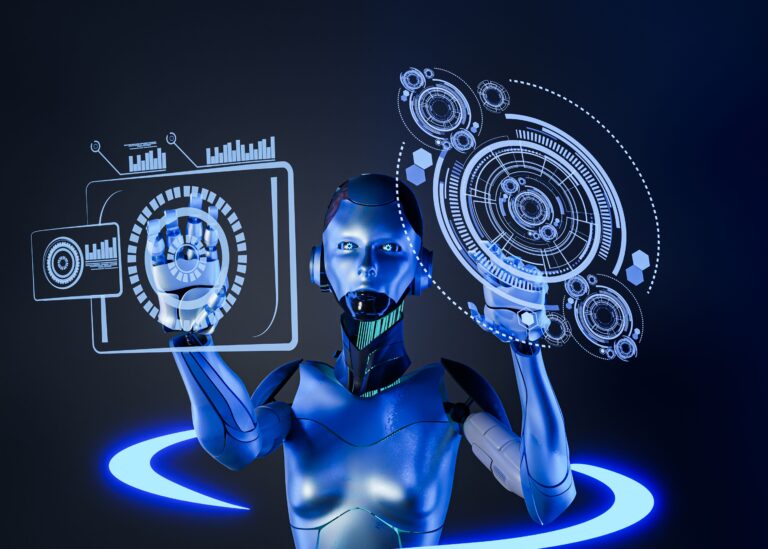The emergence of AI-driven predictive analytics is transforming business practices in our data-driven world. With access to large amounts of data, organizations can make well-informed, strategic decisions important for their future success. However, handling all this data can be hard without the right tools. This is where artificial intelligence (AI) becomes important in helping businesses predict what might happen next.
AI-driven predictive analytics helps businesses look into the future with amazing accuracy. Instead of reacting to problems after they happen, companies can plan ahead. Experts say the predictive analytics market could reach $28.1 billion by 2026, mainly because of AI and machine learning (Acumen Research and Consulting, 2022). As things get more competitive, predictive analytics isn’t just helpful it’s something businesses must have. AI is what makes this possible.
In this article, we’ll explain how AI-driven predictive analytics makes improvement and helps companies make smarter choices using data.
What is Predictive Analytics?
Predictive analytics is a way of using data to make predictions about the future. It looks at current and past data to find patterns and trends that can help people make better decisions. For example, businesses might use it to forecast sales, figure out which customers might leave, assess risks, or plan how much stock they’ll need.
In the past, predictive analytics used methods like linear and logistic regression, decision trees, and neural networks. Data experts would create models using tools like Python or R to find connections between different things in the data and make predictions.
AI-driven predictive analytics builds on these traditional methods by using technologies like machine learning, natural language processing (NLP), and deep learning. These AI tools make the process faster and smarter, handling tasks like preparing data, choosing the right algorithms, building models, and uncovering useful insights. What makes AI stand out is its speed, ability to handle large amounts of data, and its capacity to keep learning and improving over time.
How AI Enhances Predictive Analytics
Let’s explore some of the key ways AI augments predictive analytics:
Automation of Complex Calculations
AI can handle massive amounts of data and run complicated calculations way faster than humans. For example, machine learning algorithms can analyze millions of data points to find patterns that would take a person months or years to discover. This gives companies real-time insights.
One great example is Pecan AI, which builds predictive models for business forecasting. Its AI engine runs thousands of algorithm combinations to give accurate predictions, customized for each business’s needs. This level of automation is only possible with AI.
Machine Learning for Continuous Improvement
A big advantage of AI is that it learns and improves as it processes more data. For instance, IBM Watson Machine Learning detects patterns and builds smarter models over time for things like predictive maintenance and financial forecasting. The more data it gets, the better it becomes at giving useful insights.
Customizable and Personalized Predictions
While traditional models follow a one-size-fits-all approach, AI creates personalized predictions. For example, Amazon and Netflix use AI to recommend products and content based on individual preferences. This customization keeps users engaged and satisfied.
In short, AI does the heavy lifting by processing big data, learning from it, and giving tailored insights to meet business needs. This allows companies to get actionable insights faster than ever before.
Key Applications of AI in Predictive Analytics for Business
There are countless ways businesses are applying AI-driven predictive analytics across functions. Some major use cases include:
- Sales Forecasting: AI analyzes large amounts of historical sales data, economic trends, demographics, weather data, competitive intelligence, and more to forecast sales with up to 95% accuracy. Dynamic pricing, production planning, and sales process optimization all rely on sales forecasts. IBM, for instance, leverages AI to provide daily sales forecasts to reduce inventory costs.
- Customer Behavior Prediction: Understanding customer behavior is critical for customer retention and acquisition. AI techniques like machine learning uncover insights like which customers are at high risk of churn based on usage patterns and demographics. Netflix leverages AI to predict which shows a user is likely to enjoy based on interests and habits. The recommendation engine has saved Netflix $1 billion by reducing churn.
- Risk Management: AI is transforming risk management across sectors like finance, insurance, healthcare, and more. For example, AI assesses credit risk by analyzing thousands of data points to generate credit scores. It also monitors transactions and usage patterns to detect fraud in real-time. According to TransUnion, AI has reduced false positives in fraud detection by up to 30%.
- Supply Chain Optimization: AI helps forecast demand more accurately, reduce waste, and prevent inventory stock outs by analyzing data like sales history, seasonality, promotions, competition, market conditions, and more. For example, Walmart uses AI to optimize delivery routes for efficiency. This has helped Walmart save $1 billion in supply chain costs (Cognilytica).
- Human Resources: AI techniques like machine learning help flag flight risks by analyzing employee survey data, HR records, and external factors that correlate with turnover. Recruitment AI streamlines talent search and assesses fit by parsing through resumes and job description text. According to IBM, 56% of HR professionals rely on AI-based recruiting tools.
As these examples demonstrate, predictive insights enabled by AI are invaluable across all core business functions.
Case Studies: Real-World Impact of AI-Powered Predictive Analytics
- Netflix: Netflix saves over $1 billion annually by using AI-based predictive analytics to curate hyper-personalized recommendations and reduce customer churn (Forbes, 2020). Machine learning algorithms analyze billions of micro-interactions to deliver suggestions tailored to individual user preferences. This results in 75% of viewer activity directly resulting from the recommendation engine. Their predictive analytics also analyze usage patterns and audience retention to forecast which new shows have the highest probability of success.
- Walmart: Walmart leverages sensor data and other historical supply chain data to predict demand more accurately (Cognilytica, 2022). This allows them to optimize inventory levels and reduce waste. For example, during hurricane season Walmart can anticipate demand surges for bottled water in specific regions and stock up accordingly. Similarly, inventory levels are dynamically adjusted during holidays based on AI-driven demand forecasts. Overall, predictive analytics has helped Walmart reduce supply chain costs by 15-20%.
- Healthcare: In healthcare, machine learning models can analyze millions of clinical records and lab tests to predict disease outbreaks and identify people at risk in advance (Deloitte, 2020). IBM Watson analyzes historical cancer data and medical literature to predict personalized treatment options for patients. This has reduced toxic chemotherapy exposure by 96% for some patients while increasing survival rates (IBM, 2022). Early disease identification through AI predictive analytics can improve clinical outcomes and save healthcare systems billions.
Challenges and Ethical Concerns in AI-Powered Predictive Analytics
While AI unlocks immense value, there are also challenges and ethical implications to consider:
- Data Privacy and Compliance: The extensive amount of data required for accurate predictions raises concerns about consumer privacy and data compliance. Businesses must be responsible for consumer data, particularly in regulated sectors like banking and healthcare. Adhering to policies like GDPR ensures transparency and consent around data use.
- Bias in Predictive Models: Like any technology, AI is susceptible to perpetuating societal biases that exist in the data used to train algorithms. For example, facial recognition algorithms have exhibited racial and gender bias. To prevent biased predictions, businesses must ensure diverse and inclusive data collection, perform bias testing, and leverage techniques like Explainable AI (XAI) to increase model transparency and accountability.
- Data Quality: “Garbage in, garbage out” applies to predictive analytics too. Low-quality data with errors, duplications, or incompleteness can significantly skew predictions. Businesses must invest in robust data collection processes and thorough data cleaning to unlock AI’s potential while mitigating risks.
In summary, businesses must holistically evaluate the risks and ethical implications when implementing AI for predictive analytics. With thoughtful data governance and AI engineering, they can harness transformative insights while prioritizing trust and transparency.
The Business Benefits of AI-Powered Predictive Analytics
When deployed strategically, responsible implementation of AI for predictive analytics delivers tremendous business value, including:
- Enhanced Strategic Decision-Making: The most significant advantage of predictive analytics is foresight which allows proactive planning. When businesses can anticipate challenges like supply shortages, hiring gaps, or dips in customer retention, they can mobilize resources more effectively. AI provides accurate predictions to optimize decisions.
- Cost Efficiency: Predictive analytics directly improves the bottom line in multiple ways – from reducing waste with demand forecasting to preventing churn. Walmart uses AI-driven inventory optimization to save over $1 billion in supply chain costs annually (Cognilytica, 2022). AI also optimizes marketing spend by predicting the ROI of campaigns in advance.
- Enhanced Customer Experiences: Personalized recommendations keep customers engaged, as evidenced by Netflix’s success. Predicting customer needs, sentiment and behavior allows brands to tailor experiences and improve satisfaction. Gartner predicts companies that leverage AI-driven personalization will increase profits by 15% by 2022 (Gartner, 2019).
In essence, predictive intelligence provides objective data-driven insights so businesses can optimize decisions and resources. This drives efficiency, agility, and competitive resilience.
Future Trends in AI-Powered Predictive Analytics
The applications of AI in predictive analytics will continue evolving as the technology advances. Some key trends to watch include:
- AI-as-a-Service (AIaaS): Simplified, scalable AI solutions provided via cloud platforms allow smaller businesses to access predictive analytics on-demand instead of building in-house capabilities. AI-as-a-service opens the door for wider adoption across industries. According to MarketsandMarkets, the AIaaS market is projected to grow from $2.6 billion in 2019 to $38.1 billion by 2026.
- Real-Time Predictive Analytics: While traditional predictive models run periodically, businesses increasingly demand dynamic insights. Advancements in streaming data platforms, 5G, IoT devices, and edge computing will enable more real-time predictive analytics across sectors. As models can analyze data and make predictions instantly, businesses can enable applications like predictive maintenance on manufacturing equipment before breakdowns occur.
- Explainable AI (XAI): Trust and transparency are becoming more important in AI-driven predictive analytics. Explainable AI techniques that reveal the rationale behind predictions will gain traction to prevent biased or spurious insights. Gartner predicts the XAI market will reach $1 billion by 2025 (Gartner, 2021).
- Big Data and IoT Integration: The proliferation of big data from IoT, mobile devices, apps, and other digital avenues provides richer and more plentiful datasets to uncover patterns and make predictions across industries. As companies adopt big data and IoT platforms, predictive analytics will become more pervasive and accurate.
Conclusion
AI is changing the game for predictive analytics. It automates complicated data tasks, finds deep insights, and enables real-time predictions. Businesses that use AI can transform faster and plan more strategically. Although there are concerns about ethics and transparency, the value AI brings to predictive insights is clear.
Right now, only 37% of businesses are using predictive analytics (Forrester, 2020), which shows there’s huge potential for growth. The message is simple: companies that want to stay ahead should start using AI-powered predictive analytics now. It helps them predict challenges, find new opportunities, and use resources more wisely, giving them a major competitive edge.

